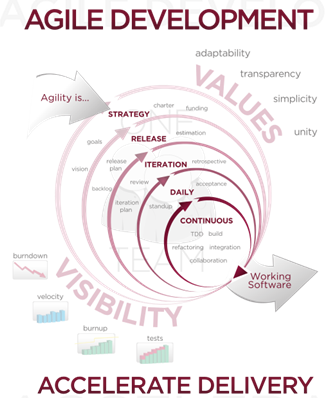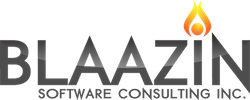Agile / Scrum Transformation
The Agile Software Development Methodology is more than just a buzzword. Since its inception more than 10 years ago, it has helped many software development teams and organizations streamline the development process and get their functionality to their customers faster. There is no single way of implementing Agile into an organization, and for that reason it can be challenging to adopt.

What is Agile / Scrum?
The focus of Agile is working software, continuous testing, frequent customer interaction, and embraces changing requirements. At every step of the development process, the customer is shown what has been produced, and has the opportunity to request changes. As a result, the end product is higher in quality, and is exactly what the customer wants. Scrum is an iterative and incremental agile software development framework for managing software development. (https://www.wikipedia.org/wiki/Scrum_(software_development)).
What will it do for me?
Transforming to an Agile / Scrum methodology leads to an organization that not only has a stronger focus on software quality and timely, feature-rich releases, but also has the ability to quickly adapt to customers’ ever changing requirements. Ultimately, this means faster time to market, fewer defects, and happier customers.
- Reduced Time-to-Market
- Research suggests about 80% of all market leaders were first to market. As well as the higher revenue from incremental delivery, agile development philosophy also supports the notion of early and regular releases, and ‘perpetual beta’.
- Improved Quality
- A key principle of agile development is that testing is integrated throughout the lifecycle, enabling regular inspection of the working product as it develops. This allows the product owner to make adjustments if necessary and gives the product team early sight of any quality issues.
- Increased Visibility
- Agile development principles encourage active ‘user’ involvement throughout the product’s development and a very cooperative collaborative approach. This provides excellent visibility for key stakeholders, both of the project’s progress and of the product itself, which in turn helps to ensure that expectations are effectively managed.
- Risk Management
- Small incremental releases made visible to the product owner and product team through its development help to identify any issues early and make it easier to respond to change. The clear visibility in agile development helps to ensure that any necessary decisions can be taken at the earliest possible opportunity, while there’s still time to make a material difference to the outcome.
- Cost Control
- The above approach of fixed timescales and evolving requirements enables a fixed budget. The scope of the product and its features are variable, rather than the cost.
- More Enjoyable!
- The active involvement, cooperation and collaboration make agile development teams a much more enjoyable place for most people. Instead of big specs, we discuss requirements in workshops. Instead of lengthy status reports, we collaborate around a task-board discussing progress. Instead of long project plans and change management committees, we discuss what’s right for the product and project and the team is empowered to make decisions. In my experience this makes it a much more rewarding approach for everyone. In turn this helps to create highly motivated, high performance teams that are highly cooperative.
- Increased Revenue
- The iterative nature of agile development means features are delivered incrementally, enabling some benefits to be realised early as the product continues to develop.
- Flexibility / Agility
- In traditional development projects, we write a big spec up-front and then tell business owners how expensive it is to change anything, particularly as the project goes on. In fear of scope creep and a never-ending project, we resist changes and put people through a change control committee to keep them to the essential minimum. Agile development principles are different. In agile development, change is accepted. In fact, it’s expected. Because the one thing that’s certain in life is change. Instead the timescale is fixed and requirements emerge and evolve as the product is developed. Of course for this to work, it’s imperative to have an actively involved stakeholder who understands this concept and makes the necessary trade-off decisions, trading existing scope for new.
- Business Engagement/Customer Satisfaction
- The active involvement of a user representative and/or product owner, the high visibility of the product and progress, and the flexibility to change when change is needed, create much better business engagement and customer satisfaction. This is an important benefit that can create much more positive and enduring working relationships.
- Right Product
- Above all other points, the ability for agile development requirements to emerge and evolve, and the ability to embrace change (with the appropriate trade-offs), the team build the right product. It’s all too common in more traditional projects to deliver a “successful” project in IT terms and find that the product is not what was expected, needed or hoped for. In agile development, the emphasis is absolutely on building the right product.
How?

Changing the culture of an organization is done using the Agile methodology itself: planned, managed, continuous changes made with the end goal in mind. Our experienced professionals will work with your Leadership and Development teams hand-in-hand to educate, plan, implement, and guide you through this exciting time. We work with the leadership team to:
